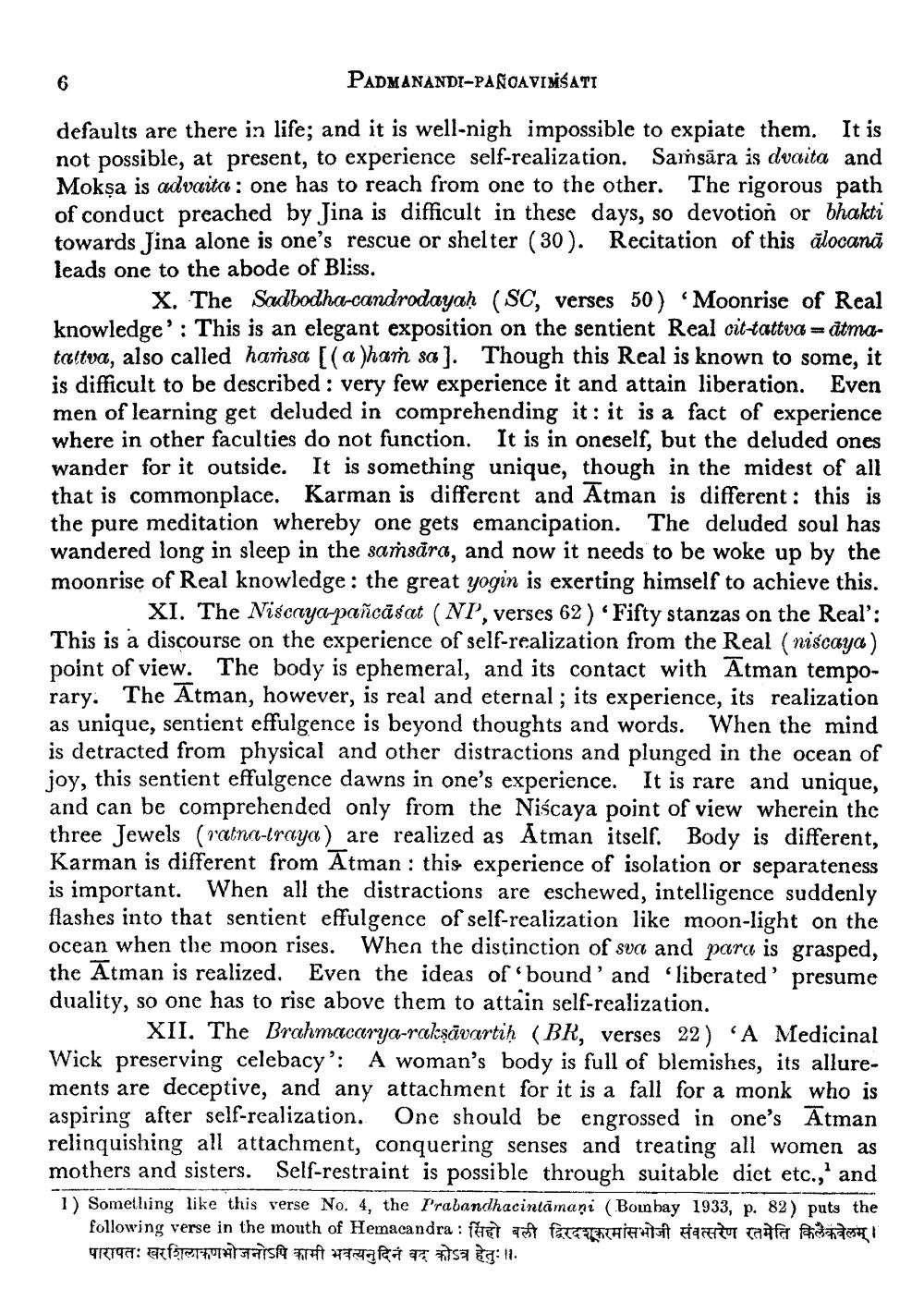________________
PADMANANDI-PANCAVIMSATI
defaults are there in life; and it is well-nigh impossible to expiate them. It is not possible, at present, to experience self-realization. Samsara is dvaita and Mokṣa is advaita: one has to reach from one to the other. The rigorous path of conduct preached by Jina is difficult in these days, so devotion or bhakti towards Jina alone is one's rescue or shelter (30). Recitation of this alocană leads one to the abode of Bliss.
6
X. The Sadbodha-candrodayaḥ (SC, verses 50) 'Moonrise of Real knowledge': This is an elegant exposition on the sentient Real cit-tattva = atmatattva, also called hamsa [(a)ham sa]. Though this Real is known to some, it is difficult to be described: very few experience it and attain liberation. Even men of learning get deluded in comprehending it: it is a fact of experience where in other faculties do not function. It is in oneself, but the deluded ones wander for it outside. It is something unique, though in the midest of all that is commonplace. Karman is different and Atman is different: this is the pure meditation whereby one gets emancipation. The deluded soul has wandered long in sleep in the samsara, and now it needs to be woke up by the moonrise of Real knowledge: the great yogin is exerting himself to achieve this. XI. The Niscaya-pañcāsat (NP, verses 62) Fifty stanzas on the Real': This is a discourse on the experience of self-realization from the Real (niscaya) point of view. The body is ephemeral, and its contact with Atman temporary. The Atman, however, is real and eternal; its experience, its realization as unique, sentient effulgence is beyond thoughts and words. When the mind is detracted from physical and other distractions and plunged in the ocean of joy, this sentient effulgence dawns in one's experience. It is rare and unique, and can be comprehended only from the Niścaya point of view wherein the three Jewels (ratna-traya) are realized as Atman itself. Body is different, Karman is different from Atman: this experience of isolation or separateness is important. When all the distractions are eschewed, intelligence suddenly flashes into that sentient effulgence of self-realization like moon-light on the ocean when the moon rises. When the distinction of sva and para is grasped, the Atman is realized. Even the ideas of 'bound' and 'liberated' presume duality, so one has to rise above them to attain self-realization.
XII. The Brahmacarya-rakṣāvartiḥ (BR, verses 22) 'A Medicinal Wick preserving celebacy': A woman's body is full of blemishes, its allurements are deceptive, and any attachment for it is a fall for a monk who is aspiring after self-realization. One should be engrossed in one's Atman relinquishing all attachment, conquering senses and treating all women as mothers and sisters. Self-restraint is possible through suitable diet etc., and 1) Something like this verse No. 4, the Prabandhacintamani (Bombay 1933, p. 82) puts the following verse in the mouth of Hemacandra : सिंहो बली द्विरदशूकरमांसभोजी संवत्सरेण रतमेति किलैकवेलम् । पारापतः खरशिलाऋणभोजनोऽपि कामी भवत्यनुदिनं वद कोऽत्र हेतुः ॥




